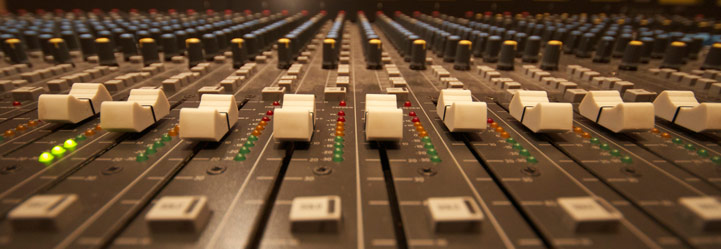As described in the syllabus, each student is required to complete 3 basic exercises/projects during the coming semester. These projects may be worked on as individuals or in small teams to consolidate equipment rental. Projects are a large portion of your grade, so take them seriously.
Deadlines to turn in all projects will be announced during the semester, based on the progress of the course. These dates will be announced so as to provide you with at least two weeks between assignments. Unless prior arrangements have been made with the instructor, late projects will be penalized; and projects not turned in by the Final Deadline will be graded as failure.
Strive to turn in your projects early enough in the semester that you are not rushed against the deadlines. Projects submitted in a timely manner allow the Instructor a chance to evaluate what you have done and to give you constructive feedback. Then, the project can be improved and re-submitted by Final Exam Day for a higher grade. But if you wait until the end of the semester, you will lose the opportunity to fix things, and will have to settle for the grade you receive.
In all cases, the last deadline for all projects is the week before Final Exams (the last official teaching day). Projects turned in after that date, are considered as having missed the client's deadline and may receive a grade of zero. Missing an important deadline can be catastrophic in the real world.
Equipment availability is a problem that you are expected to learn to deal with. Do not wait until the last minute to make your equipment reservations! Do not seriously expect most equipment to be available over holiday weekends, when most student films are being shot.
When you do check out equipment, take some time and make sure that everything is present and that everything works! Do not leave the checkout room until you have gone through everything very carefully. Remember, not only will faulty or missing equipment jeopardize your project, but it is your signature on the rental contract and you can be held financially liable! Note that the Equipment Room personnel have been instructed to purposely include defective equipment in your package, in order to insure that you take the time to properly prep your gear!
There are solutions to the equipment shortage. Plan ahead, order early. Work in groups! Rent or borrow equipment from outside sources. (Remember, the money that you are not spending on textbooks can be pooled and used to rent gear.)
Finally, don’t be afraid to call your instructor. My primary function is to help you learn, not to rule by terror.
Description of Projects
In addition to the recording itself, students are required to write a brief summary discussing the equipment/techniques, problems encountered, and general findings or conclusions for each project. Although some projects may be completed as groups, papers must be written on an individual basis. Papers allow you to discuss not only what happened when you did the projects, but what you might have done differently if presented with the opportunity. Since groups rarely contribute equally, your paper is a chance to rise above the lowest common denominator, so to speak.
Package all paperwork from ALL group members in a neatly labeled manila envelope along with your project, so everything is together. In the real/reel world, neat packaging & professional presentation are important, so get used to it. Each project packet should include: the CD or DVD, neatly labeled and in a protective sleeve or case; one log sheet detailing the contents of the recording; and summary papers from each and every group member.
Always include your first and LAST names. I deal with a lot of students; not just from this class. Any names handwritten and added to a paper or project after it has been formatted & printed will not count.
All recorded projects MUST include a detailed index or log sheet identifying each take or file being submitted. At the top of the sheet should be general information, including your name, project title/name, and recording specs (type of recorder, format, bit/sampling rate, timecode, what the reference tone level is). The index or log sheet should accurately reflect what is on the CD or DVD only. It is not a history of your shooting day; but rather a table of contents for what is on the disk. Make sure that the file names, as read on the disk, match what is on the log. Each log entry should show: filename, scene/take number, description, names of mixer/boom, and general comments.
All audio projects must be turned in as digital audio files, formatted in the preferred industry formats of WAV or BWF. Video projects must be turned in as standard DVD, playable in consumer DVD players. DO NOT turn in your video projects as QT, MOV, or AVI files. There is no excuse for a film major to not know how to create a standard DVD. Make sure that your disk plays correctly in a machine other than where you burned it.
You may also post your completed video projects to an online streaming video source, such as YouTube or Vimeo and provide me with the links.
All recorded projects MUSTinclude a header ID and reference tone. Video projects should include color bars along with audio tone.
The Header I.D.
First thing recorded onto any recording is the voice slate or header i.d. Include your names, course, semester, and project title. Also include audio format (mono track, two-track, etc.), type of recorder, the recording specs such as bit rate & sampling rate, the timecode rate if applicable (23.97, 24, 29.97 drop, 29.97 non-drop, 30 non-drop, etc.), and what is the upcoming reference tone level. (usually –20dB; or a value between –15 to –24 dB on digital audio recordings). Then go ahead and record 30 seconds of tone.
Special Note: You will be asked about header i.d.’s on a few written tests, so study the preceding paragraph!!
In all instances, remember to slate verbally and write on the log what the reference level is.
Project One - Recording Basics: Interviews
Each team of (not more than two) students will record two brief (under one minute) documentary/ENG style audio interviews. Audio should be recorded onto a portable audio recorder such as a TASCAM, Zoom, Sound Devices, Marantz, Fostex, etc., but NOT a laptop nor a camcorder. Audio should be turned in as digital WAV or BWF files on a CD. Do not edit, transcode, nor combine files. Just drag & drop the originals, along with your header file, onto a disk, and finalize. No CDA file music formats.
If you can, try to demonstrate different microphones and techniques. For example: Man-on-the-street using a handheld dynamic mic. Or, a two person sit-down with both parties wearing lavaliers, or two person sit-down using an overhead boom. The purpose of this exercise is to encourage you to become familiar with at least one portable recorder, and to explore the capabilities of different mics. Have fun with it. Experiment with different selections, placements, angles, distances, etc.
Include written comments on what you did and what you concluded. Papers must be prepared individually by each member of the team. Neatness and professional presentation count… take the time to make sure what you turn in reflects your high level of academic achievement.
Explain what equipment (make sure you get the makes and models correct!) & techniques were used, any problems encountered (and how you dealt with them), and any general comments. The papers do not have to be lengthy; a page or two should suffice. I am not looking for essays nor re-iterations of my lectures.
Include an INDEX/ LOG SHEET of the contents.
At the top of the sheet should be general information, including your name, project title/name, and recording specs (type of recorder, format, bit/sampling rate, timecode, what the reference tone level is). The log sheet should accurately reflect what is on the CD or DVD only. It is not a history of your shooting day; but rather a table of contents for what is on the disk. Make sure that the file names, as read on the disk, match what is on the log. Each log entry should show: filename, scene/take number, description, names of mixer/boom, and general comments.
Each individual on the team must take a turn as Mixer, and they must identify themselves before each take (in other words, do at least one interview per student on your team). Each team’s project must be complete, including a verbal headslate/i.d. at the head of the tape (described previously), voice identify what level the reference tone (headtone) is. Before each take, voice slate the scene/take number or identifier.
Pay attention to packaging… keep it neat and organized. Note that making a clean recording is rather simple; the challange of this exercise is to pay attention to workflow details: format, header ID, ton, voice slates, paperwork.
When recording in digital: Always verbally slate or i.d. each project (in the field, always i.d. each media card that you use). Your verbal headslate should include project name, recording format, type of recorder, sampling & bit rate, timecode rate, and reference tone level (usually –20dB; or something between –15 to –24 dB). After the field recording, you will transfer your audio files to a computer hard-drive and then copy your audio “dailies” to data CD or data DVD, which go to Post-Production.
Digital audio recordings will be submitted to the Instructor on CD -- formatted as WAV or BWF -- and neatly labeled (handwritten with a Sharpie is OK). Make sure you package your disk in a protective sleeve or plastic case.
Include one detailed index/log in the box. Don’t forget for each person to write a short summary paper describing your approach, conclusions, etc.
Turn in your disk and all paperwork together in one manila envelope.
Project Two - Production Mix (Dramatic)
Every team of (two) students will assume the role of Production Sound Mixer or Boom Person and mix at least two minutes of cinematic dialogue between two or more different actors. There should be actor movement (walking) and conversation between talent — two uninterrupted “monologue” sets of lines don’t constitute much of a challenge. The mix should simulate actual dailies and filmmaking (or television) environment. There should be a master scene, followed by “coverage” or closer angles, including a medium shot and singles.
I am not looking for a completed film, nor grading the acting, script, lighting, etc. I am interested in viewing the unedited DAILIES. The quality of the PRODUCTION SOUND is most important, as you might guess!
Shoot picture with a video camcorder. Mix audio with a mixing panel and record audio directly onto video (or double system onto an audio recorder and combine the audio with video in “post”).
You may need to borrow an XLR-DV or similar audio interface cable or adapter box to plug into a common camcorder or DSLR (stereo mini connector) if your camcorder lacks professional XLR inputs. If you prefer, you may also record double system onto a separate audio recorder.
Video (with audio) will be turned in on conventional playable DVD, or be posted onto a streaming site such as Vimeo, orYouTube. Do not turn in video files formatted as QT, MOV, or AVI, as those files require transfer to a hard drive in order to play smoothly. Your video DVD must be able to play in a standard, consumer DVD player, as that is what you would find in most clients' offices.
When you turn in a DVD, it is your responsibility to make sure that the DVD plays okay in a standard DVD player (not just the editing machine burner).
You MUST include color bars and an audio reference tone at the beginning of the project (and verbally slate what level the tone is).
As an alternative, your Production Mix could constitute dailies from a project done in conjunction with a film or video project for other production courses or the 123 Cycle Film Productions. These real film experiences are encouraged and welcomed. Make arrangements to “copy” the unedited takes in question for instructor evaluation.
Grading will be based on complexity of the challenge as well as quality of the raw (unedited) mix. Make these projects reflect your professionalism and high standards. They should be representative of students who are about to earn a university degree in filmmaking. Only turn in your best work; leave the bad takes out. If the shoot was a disaster, then do it again; but DO NOT turn in unsatisfactory projects unless you want an unsatisfactory grade.
Do not forget to include a summary paper from each team member describing your approach, the problems encountered, how you dealt with them, etc. Make sure to label your project neatly and professionally. Include one index/log sheet that specifies who is mixing/booming on each take, and what the audio reference tone is. Package the tape and paperwork together in a manila envelope.
Although you are encouraged to work in larger groups in order to share resources, each team of 2 students (mixer & boom) must mix a complete set of takes and submit their own work in its own envelope. It is okay for larger groups to share common setups, scripts, actors, etc – so long as each team mixes their own takes.
Make sure that you check and PLAY BACK your project prior to turning it in. You would be amazed at how many projects get turned in that are defective transfers lacking presentable audio tracks!
Custom Projects
Students with prior or concurrent recording, transferring, or mixing experience may arrange to do custom or optional projects in lieu of the standard assignments. Consult with the instructor to work something out. Work done or being done for other production classes or projects may be applicable; ask. The instructor does not believe in busy work; your time is valuable, so let’s do something meaningful with it!
Project Three - Pre-production Sound Budget
Prepare a detailed budget and equipment checklist for Production Sound for a hypothetical seven day, local video shoot. (M,T,W,TH, F, hiatus, T,W) This budget is to be a "professional" version of the dramatic shoot (Project 2) that you have recently completed….
Figure rates for personnel, equipment, and expendables that you would submit to the Producer. Be as realistic as possible. Ask around town; ask pro mixers; learn something! DO NOT merely re-copy the class handouts. Treat this project as if it were the real thing! Attach realistic dollar figures to everything (no freebies, donations, etc.)
Be professional in your presentation; you must impress the producer if you are going to be considered for the job. Neatness and logical presentation count! Pretend this is for an actual client. Someday you may be on the receiving end of these budgets; learn how to recognize gross incompetence before it comes out of YOUR production bank account.
Hint: Do NOT imply that you are a student working on a student budget assignment. Although some rental houses will spend time with you, many will brush you off as a waste of their time if they think there is no $$$ potential.
For example, convince them that you are a new hire at a company and have been appointed (due to your film school background) as the in-house producer for a company project.
This project may be submitted as a team effort by a group of any size in order to conserve paper and photocopier toner! But larger “groups” will be evaluated to a higher standard, since there are more people to share the burden of research & presentation.
This budget is a serious project! Make it as complete as possible; and make your presentation look professional.
Your written presentation shall be multiple pages, composed of the following sections. Each section should start on a fresh page.
Section One: Introduction
First, write a brief synopsis of the shoot or project to be undertaken. It must involve multiple actors or contestants, judges, commentators. It should be full-scale (unlike your own projects completed above).
Tell us the number of shooting days (see above), and the types of locations.
Assume that audio will be recorded onto a professional multi-track field recorder as well as direct to video for on set playback . Make sure you have the right hookups for the mixing panel, and out to camera.
Section Two: Costs for Personnel
Present the rates for your Sound crew. Show the daily rates for Mixer, Boom, Utility, and any other personnel that you require. Base the rate on a standard working day (and you must define your standard day for the Producer). From the basic day rates, calculate a rate for weekly (and define what is considered as Weekly). Lastly, calculate a total for entire duration of the shoot for each person; as well as a grand total for all personnel.
In footnotes, also define when Overtime rates would kick in, and indicate the overtime rate for each person.
You do not need to cover travel days, per diem, meal penalties, etc.
Section Three: Equipment Costs
Present the rates for all of the Sound Dept's equipment and expendables. List each item or package, along with its Daily rental rate, Weekly rate, and Total for the duration of the shoot. When listing a package, specify what that package includes.
Do NOT just present the physical quotations that you received from the rental houses. Instead, use them to produce your own list of equipment costs. You will append the actual quotations to the end of the section.
Don’t forget to present any weekly discounts on equipment packages, when applicable.
List your expendables, along with an approximate flat rate for Weekly and Total. (Always indicate that the costs of Expendables are an Approximation, as one cannot predict with certainty an exact quantity that will be consumed.)
Make sure that your footnotes define Weekly Rate and any other pertinent discounts or surcharges.
Make sure that you specify Insurance requirements, deposits, surcharges, shipping charges (if applicable). If the Producer is to provide or pay for Insurance coverage, be sure to specify it.
Include the sources (rental companies, soundmixers, etc.) that you used to research this project, along with info about the person (name, company, position, date of quote) who provided you with the tech advice/pricing for your package. Make sure that a real person helps you put together your package. Append copies of quotations, rental catalog pages, etc. that you have used to research your prices.
Do not just list items that you do not understand or copied blindly from the net or a brochure! Although you may call me or my teaching assistants with specific technical questions, do not expect us to complete your budget assignment for you, nor provide rates for this assignment. Be resourceful – the United States is a big place!
Section Four: Packing List
Your presentation MUST Include a detailed item by item inventory list of everything that you will be bringing or shipping to location, whether rented or owned.
Be extremely specific in your descriptions. List every item by (correct) make and model that you will be packing. Pay particular detail to the small adapters and accessories that you will need. Describe all adapter cables by the type of connection on either end (e.g. XLR-female to RCA-male). Remember to include EVERY ITEM that your sound package will require, such as shockmounts, windscreens, zeppelins, and so on. If some accessories are included with a particular rental item, you must specify this. (Example, a rented microphone may include a foam windscreen; but not a full zeppelin, which might be a separate rental line item.)
Make sure that you are bringing everything needed to make your equipment package usable. Failing to provide the right connector cables, power supplies, shockmounts, or other interfaces means that you will NOT be able to function on the day of the shoot. Getting a list of the big equipment is easy; but it requires meticulous attention to detail to insure that you will have all of the little bits needed to interconnect the big stuff. Ask lots of questions, and then ask more. Follow the "signal path" from microphone all the way to recorder, and make sure that everything that you will need is accounted for.
Add a brief description of what each item will be used for and why you feel that you need it. Too many students tend to just randomly list a lot of gear without having any understanding of why or how they would ever utilize it on a set. Get used to defending your equipment list; there are some cheapskate producers who will always question you about your required needs.
Do NOT just copy catalog descriptions about the gear; I want to read your own brief explanation of what each piece of equipment does and why you chose a particular item. For example, “Acme Shortie-1222 condenser cardioid mic. Wide angle, short range, boom mic. For eliminating echo indoors.”
It is imperative that you pay close attention to all of the little things, such as adapter cables for interconnecting recorder, mixing panel, audio out to the Boom Operator, and timecode interfaces. Without the right adapters, none of the expensive toys will do you any good on a production!






